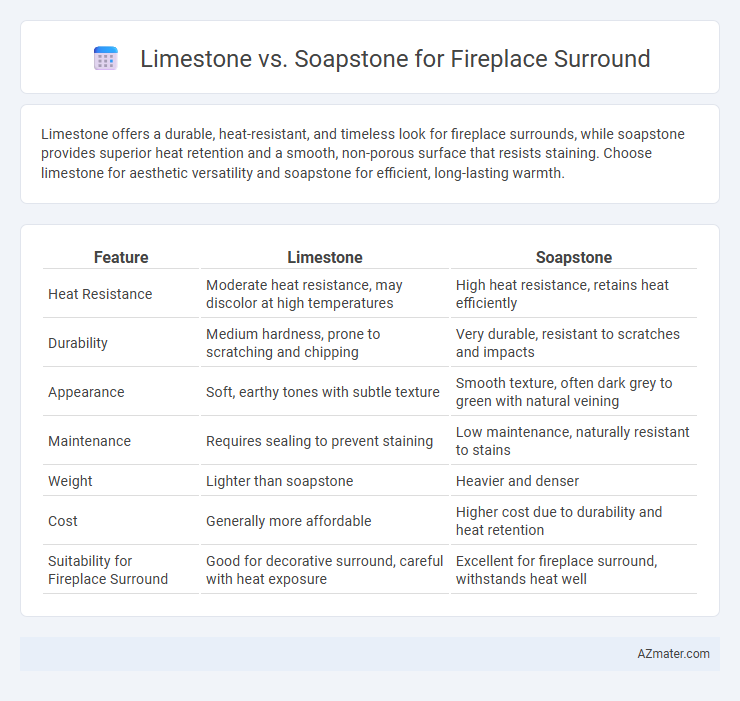Limestone offers a durable, heat-resistant, and timeless look for fireplace surrounds, while soapstone provides superior heat retention and a smooth, non-porous surface that resists staining. Choose limestone for aesthetic versatility and soapstone for efficient, long-lasting warmth.
Table of Comparison
| Feature | Limestone | Soapstone |
|---|---|---|
| Heat Resistance | Moderate heat resistance, may discolor at high temperatures | High heat resistance, retains heat efficiently |
| Durability | Medium hardness, prone to scratching and chipping | Very durable, resistant to scratches and impacts |
| Appearance | Soft, earthy tones with subtle texture | Smooth texture, often dark grey to green with natural veining |
| Maintenance | Requires sealing to prevent staining | Low maintenance, naturally resistant to stains |
| Weight | Lighter than soapstone | Heavier and denser |
| Cost | Generally more affordable | Higher cost due to durability and heat retention |
| Suitability for Fireplace Surround | Good for decorative surround, careful with heat exposure | Excellent for fireplace surround, withstands heat well |
Introduction to Fireplace Surround Materials
Limestone and soapstone are popular natural stone materials for fireplace surrounds, each offering distinct aesthetic and functional benefits. Limestone provides a classic, elegant look with a lighter color palette and a smooth texture, while soapstone is prized for its heat retention and durability, featuring darker tones and a slightly softer feel. Choosing between limestone and soapstone depends on factors like heat resistance, maintenance requirements, and overall design preferences for the fireplace surround.
Overview of Limestone and Soapstone
Limestone is a sedimentary rock composed mainly of calcium carbonate, valued for its natural, light-toned appearance and durability in fireplace surrounds. Soapstone, a metamorphic rock rich in talc, is prized for its heat retention, smooth texture, and resistance to staining and cracking. Both materials offer unique aesthetic and functional properties, with limestone providing a classic, elegant look and soapstone excelling in thermal performance and low maintenance.
Aesthetic Appeal: Limestone vs Soapstone
Limestone offers a light, natural look with subtle veining and warm beige to gray tones, providing a classic and elegant aesthetic for fireplace surrounds. Soapstone features a smooth, matte finish with darker gray to deep green hues, creating a modern, sleek appearance that enhances contemporary interior designs. The choice between limestone and soapstone depends on whether a softer, traditional ambiance or a bold, minimalist statement is desired for the fireplace surround.
Durability and Longevity Comparison
Limestone and soapstone are popular materials for fireplace surrounds, each offering distinct durability and longevity characteristics. Limestone is softer and more porous, making it more susceptible to scratches, chipping, and heat-related damage over time. Soapstone, composed primarily of talc and magnesium silicate, excels in heat resistance and is highly durable, often lasting decades without significant wear, making it the superior choice for longevity in high-temperature environments.
Heat Resistance and Performance
Limestone and soapstone differ significantly in heat resistance and performance for fireplace surrounds, with soapstone offering superior thermal properties due to its high density and ability to absorb and radiate heat evenly. Soapstone's heat retention ensures prolonged warmth distribution, enhancing energy efficiency and comfort in living spaces. Limestone, while aesthetically pleasing, is less heat-resistant and more prone to cracking under rapid temperature changes, making it less durable for high-heat applications near fireplaces.
Maintenance and Cleaning Requirements
Limestone fireplace surrounds require regular sealing to prevent stains and moisture damage, with gentle cleaning using mild soap and water to preserve their porous surface. Soapstone offers superior durability and resistance to heat and stains, requiring minimal maintenance beyond occasional wiping with water or a mild detergent. Both materials benefit from avoiding harsh chemicals, but soapstone's non-porous nature makes it easier to maintain a clean appearance over time.
Cost Differences: Limestone vs Soapstone
Limestone fireplace surrounds generally cost between $15 to $30 per square foot, making them a more budget-friendly option compared to soapstone, which ranges from $30 to $60 per square foot. The price difference is primarily due to soapstone's higher density and heat retention properties, which enhance durability and thermal performance. Homeowners often choose limestone for lower initial investment, while soapstone appeals to those seeking long-term value and a heat-efficient surround.
Eco-Friendliness and Sustainability
Limestone is a sedimentary rock formed from marine sediments, offering moderate eco-friendliness due to its natural abundance and low processing emissions, making it a sustainable choice for fireplace surrounds. Soapstone, composed mainly of talc and magnesium silicate, has a lower environmental impact thanks to its durability and heat retention properties, which reduce energy consumption over time. Both materials support sustainability, but soapstone's longevity and thermal efficiency give it a slight advantage in reducing carbon footprint.
Suitability for Different Home Styles
Limestone offers a classic, soft-textured appearance that complements traditional and rustic home styles, enhancing cozy and warm fireplace surrounds. Soapstone features a smooth, dense surface with subtle veining, making it ideal for modern and contemporary homes seeking a sleek, durable, and heat-retentive fireplace surround. Both materials provide fire-resistant properties, but the choice depends on the desired aesthetic--limestone for timeless elegance and soapstone for minimalist sophistication.
Final Verdict: Choosing the Right Stone for Your Fireplace Surround
Limestone offers a classic, elegant look with a porous texture that absorbs heat gradually, making it ideal for traditional fireplace surrounds with moderate heat exposure. Soapstone provides superior heat retention and durability, resisting cracks and stains, which makes it perfect for high-heat fireplaces and contemporary designs. Choosing between limestone and soapstone depends on your aesthetic preference and functional needs, with soapstone favored for long-lasting heat performance and limestone preferred for its timeless natural beauty.

Infographic: Limestone vs Soapstone for Fireplace Surround
 azmater.com
azmater.com